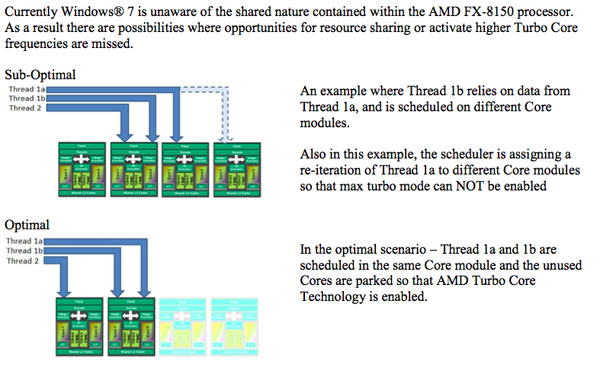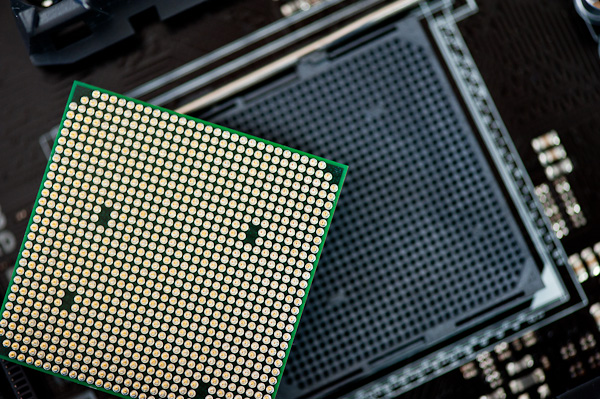The Bulldozer Review: AMD FX-8150 Tested
by Anand Lal Shimpi on October 12, 2011 1:27 AM ESTFinal Words
In many cases, AMD's FX-8150 is able to close the gap between the Phenom II X6 and Intel's Core i5 2500K. Given the right workload, Bulldozer is actually able to hang with Intel's fastest Sandy Bridge parts. We finally have a high-end AMD CPU with power gating as well as a very functional Turbo Core mode. Unfortunately the same complaints we've had about AMD's processors over the past few years still apply here today: in lightly threaded scenarios, Bulldozer simply does not perform. To make matters worse, in some heavily threaded applications the improvement over the previous generation Phenom II X6 simply isn't enough to justify an upgrade for existing AM3+ platform owners. AMD has released a part that is generally more competitive than its predecessor, but not consistently so. AMD also makes you choose between good single or good multithreaded performance, a tradeoff that we honestly shouldn't have to make in the era of power gating and turbo cores.
Bulldozer is an interesting architecture for sure, but I'm not sure it's quite ready for prime time. AMD clearly needed higher clocks to really make Bulldozer shine and for whatever reason it was unable to attain that. With Piledriver due out next year, boasting at least 10-15% performance gains at the core level it seems to me that AMD plans to aggressively address the shortcomings of this architecture. My only concern is whether or not a 15% improvement at the core level will be enough to close some of the gaps we've seen here today. Single threaded performance is my biggest concern, and compared to Sandy Bridge there's a good 40-50% advantage the i5 2500K enjoys over the FX-8150. My hope is that future derivatives of the FX processor (perhaps based on Piledriver) will boast much more aggressive Turbo Core frequencies, which would do wonders at eating into that advantage.

AMD also shared with us that Windows 7 isn't really all that optimized for Bulldozer. Given AMD's unique multi-core module architecture, the OS scheduler needs to know when to place threads on a single module (with shared caches) vs. on separate modules with dedicated caches. Windows 7's scheduler isn't aware of Bulldozer's architecture and as a result sort of places threads wherever it sees fit, regardless of optimal placement. Windows 8 is expected to correct this, however given the short lead time on Bulldozer reviews we weren't able to do much experimenting with Windows 8 performance on the platform. There's also the fact that Windows 8 isn't expected out until the end of next year, at which point we'll likely see an upgraded successor to Bulldozer.

So what do you do if you're buying today? If you have an existing high-end Phenom II system, particularly an X4 970 or above or an X6 of any sort, I honestly don't see much of a reason to upgrade. You're likely better off waiting for the next (and final) iteration of the AM3+ lineup if you want to stick with your current platform. If you're considering buying new, I feel like the 2500K is a better overall part. You get more predictable performance across the board regardless of application type or workload mix, and you do get features like Quick Sync. In many ways, where Bulldozer is a clear win is where AMD has always done well: heavily threaded applications. If you're predominantly running well threaded workloads, Bulldozer will typically give you performance somewhere around or above Intel's 2500K.
I was hoping for Bulldozer to address AMD's weakness rather than continue to just focus on its strengths. I suspect this architecture will do quite well in the server space, but for client computing we may have to wait a bit longer for a more competitive part from AMD. The true culprit for Bulldozer's lackluster single-threaded performance is difficult to track down. The easy answer would seem to be clock speed. We've heard of issues at Global Foundries and perhaps Bulldozer is the latest victim. If AMD's clock targets were 30% higher than Phenom II, it simply didn't make them with the FX-8150. I've heard future derivatives will focus more on increasing IPC indepedent of process technology and clock speed, but if you asked me what was the one limit to success I would say clock speed. As a secondary factor, AMD appeared to make some tradeoffs to maintain a reasonable die size at 32nm. Even then Bulldozer can hardly be considered svelte. I suspect as AMD is able to transition to smaller transistor geometries, it will be able to address some of Bulldozer's physical shortcomings.
The good news is AMD has a very aggressive roadmap ahead of itself; here's hoping it will be able to execute against it. We all need AMD to succeed. We've seen what happens without a strong AMD as a competitor. We get processors that are artificially limited and severe restrictions on overclocking, particularly at the value end of the segment. We're denied choice simply because there's no other alternative. I don't believe Bulldozer is a strong enough alternative to force Intel back into an ultra competitive mode, but we absolutely need it to be that. I have faith that AMD can pull it off, but there's still a lot of progress that needs to be made. AMD can't simply rely on its GPU architecture superiority to sell APUs; it needs to ramp on the x86 side as well—more specifically, AMD needs better single threaded performance. Bulldozer didn't deliver that, and I'm worried that Piledriver alone won't be enough. But if AMD can stick to a yearly cadence and execute well with each iteration, there's hope. It's no longer a question of whether AMD will return to the days of the Athlon 64, it simply must. Otherwise you can kiss choice goodbye.











430 Comments
View All Comments
kiwidude - Wednesday, October 12, 2011 - link
I think this shows what a great job Intel have been doing more than confirming your insulting comment about AMD engineers.JohanAnandtech - Wednesday, October 12, 2011 - link
"Brand new and spanking Bulldozer has it roots in ancient K6"There is some K7 heritage left, but I can not see in any way how this CPU relates to the K6! The K6 had a very short pipeline, a unpipelined FPU for example.
As when it comes to the server market: AMD seems to have overclocked and cherry picked the 3.6 GHz FX-8100. For the desktop market, clockspeed rules, so AMD didn't care too much about power consumption.
For the server market, they can go with lower clocked 95 W TDP parts. These should have a much better performance/watt ratio. Also, the server market runs at 30-80% CPU load, the desktopmarket runs a few cores at 100%. So the powermanagement features will show better results in the server market.
The gaming software needs fast caches (latency!) as IPC is decent. The server software is more forgiving when it comes to cache latency as IPC is more determined by the number of memory accesses and thread synchronization. That is the reason why that L3 is so handy. I think you should wait to condemn bulldozer until it is has been benchmarked on our server benchmarking suite.
I am worried about the legacy HPC performance of this chip though.It will take some recompiling before the chip starts to shine in this market.
FunBunny2 - Wednesday, October 12, 2011 - link
Had to get this far in the comment thread for sanity. Clearly, AMD (and one may disagree) has chosen to go for superior integer performance in a threaded architecture. D'oh! So what? It means they don't give a rat's rectum about gamers. They care a whole lot about application and database servers. They also accept the fact that single threaded is dying, so just kill it.Makaveli - Wednesday, October 12, 2011 - link
I stayed up and read this its 2 in the morning excellent review as always anand.But instead of back to the future its back to the P4???
Why AMD WHY for the love of everything holy!
Sind - Wednesday, October 12, 2011 - link
Disappointing.. I hope they can get it together with the aggressive road map.wolfman3k5 - Wednesday, October 12, 2011 - link
I know, right. I'm also patiently waiting for the AMD Bendover architecture. Maybe it will be competitive, who knows...kiwidude - Wednesday, October 12, 2011 - link
Hi, the CPU Specification Comparison chart has incorrect info listed under X6 1100T and X4 980 NB clocks. Great review as always love your work.wolfman3k5 - Wednesday, October 12, 2011 - link
NewEgg doesn't even have any Bulldozers in stock, at all. Not the AMD FX 8150 or AMD FX 8120. I guess that no one is in a hurry to grab one...enterco - Wednesday, October 12, 2011 - link
Hell, Amazon UK doesn't have any Bulldozer neither...ckryan - Wednesday, October 12, 2011 - link
Maybe Newegg filed them under Server CPUs where BullDozer belongs.